In this article, we’re going to take a look at Dog Lichen or as it is formally known, Petigera canina.
More specifically, we’re going to look at what causes it, how to get rid of it and how to prevent it from growing back through good lawn care practices.
What is Dog Lichen?
Dog Lichen is often mistaken for fungi when in fact, it’s a mixture of fungus and algae living and working together in symbiosis.
The algae supply the fungus with a source of food and in return, the fungus provides a home for the algae to live with a ready water source.
What it Looks Like
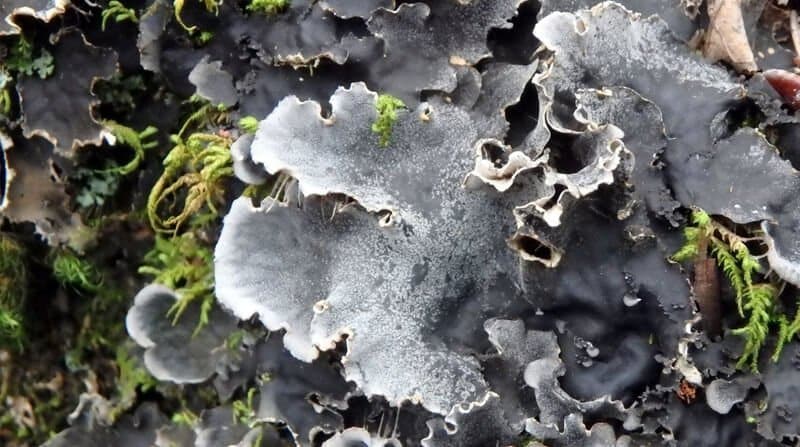
They have grey/black scales that spread over the lawn.
These scales, also known as a thallus, can grow between 3-5cm across. They’re often white on the underside and grey or black on the topside and appear papery when the weather is dry. In wet conditions, they plump up as they absorb moisture.
What Causes it
Dog Lichen is a sign that your lawn is in a very poor state.
It thrives on compacted, poorly draining, nutrient-deficient soils, often in shaded areas with poor air circulation. You’ll often see it mixed in areas of moss as they thrive in very similar conditions.
Because water can’t drain away, the surface moisture is the perfect place for the fungus to incubate and grow. If a species of symbiotic algae bacteria are present in the lawn, then Dog Lichen will start to grow.
As such, you’ll see it grow in times of heavy rainfall, mostly in winter.
How to Remove Dog Lichen From Your Lawn
As you know, Dog Lichen isn’t a weed so it’s not something which can be controlled with chemicals.
Even if you could treat it chemically, the presence of Dog Lichen in your lawn is a symptom of other problems. Without addressing these problems, it would come straight back.
The good news is that it’s not very tolerant of changes in growing conditions. If you can change growing conditions to favour the grass, you’ll remove Dog Lichen and prevent it from growing back
In order to create growing conditions to benefit the grass, you’ll need to renovate, or at least partly renovate your lawn.
Because Dog Lichen thrives in the winter, you’ll want to do this renovation in the spring when conditions for grass growth are at their best. Between April and May is generally best.
Follow these steps;
Step 1: Kill and Remove Any Moss
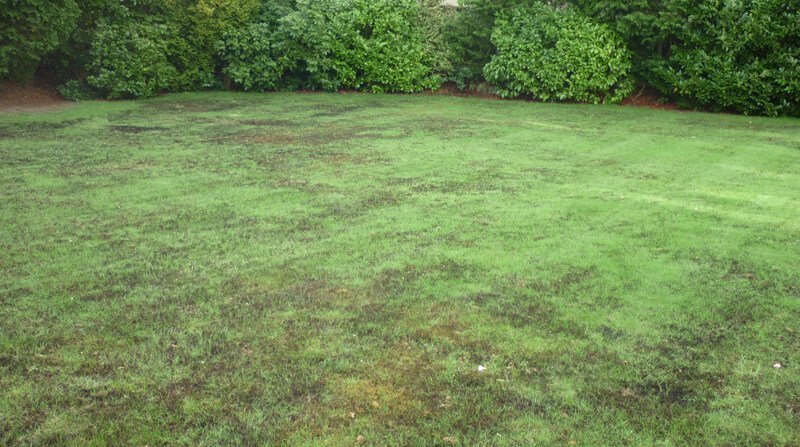
Dog Lichen thrives on compact, poorly draining, nutrient-deficient soils where lots of moss is present. So we first need to remove the moss.
Apply your preferred moss killer and leave it for 7-10 days so it works it’s way into the moss and kills it dead. If you don’t know which kind of moss killer to use, take a look at my moss killer reviews.
Once the moss is dead, rake it out.
My advice is to use a powered lawn rake. You can use a springbok rake but be prepared for a lot of hard work and blistered hands. A powered lawn rake will make it a LOT easier.
Step 2: Scarify to Remove Lawn Thatch
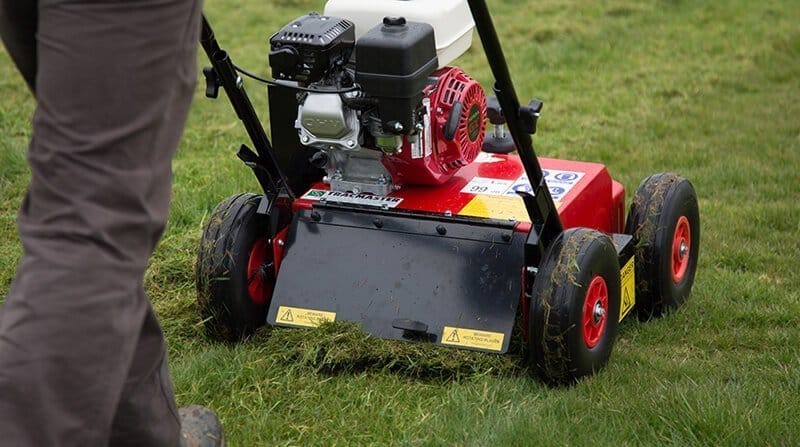
Lawn thatch is made up of dead old grass roots, shoots and clippings mixed in with other organic matter.
It lies just under the surface, in amongst the root zone.
Some thatch is a good thing, it protects the grass plant and keeps the lawn healthy. Too much thatch, however, prevents water, air and nutrients from penetrating the soil.
By removing excess thatch, you open up the soil to receive the nutrients it has been starved of.
Scarifying uses vertical blades to pull thatch out of the surface. If you have a small lawn a hand scarifier will do, however, if you have anything larger than 30 square meters, use a powered scarifier. It’ll save you hours of really hard graft.
For more information about lawn scarifiers, take a look at my article: Best Lawn Scarifier: Petrol, Electric, or Manual? Reviews of My Top Choices and In-Depth Buyers Guide
Step 3: Aerate to Relieve Soil Compaction
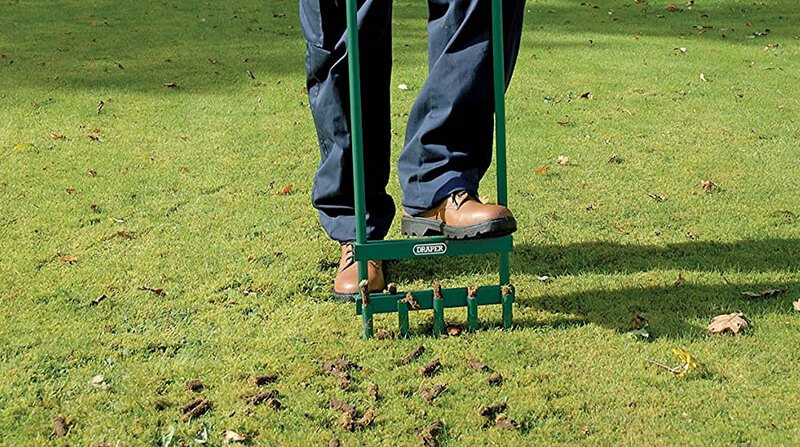
Now that you’ve removed the moss and thatch, you can start to work on the soil.
As you know, Dog Lichen thrives on poorly draining soils. One of the reasons soil doesn’t drain is because it becomes compacted. With constant use, soil particles get squeezed together, pushing out water, air and nutrients. The particles get so squeezed that nutrients can’t penetrate the soil at all.
In order to relieve this compaction, you should aerate the lawn with a hollow tine aerator. This removes hundreds, even thousands of cores of turf 2-3 inches deep which create space for the soil to relax and the particles to separate from each other.
This, in turn, means water, air and nutrients can penetrate the soil.
You can buy manual hollow tine forks or hire a machine from your local hire shop. Hollow tine forks can be used effectively but it’s hard work, even on small lawns. If you have large areas, hire a machine.
Step 4: Top Dress Your Lawn with a Nutrient-Rich Topsoil
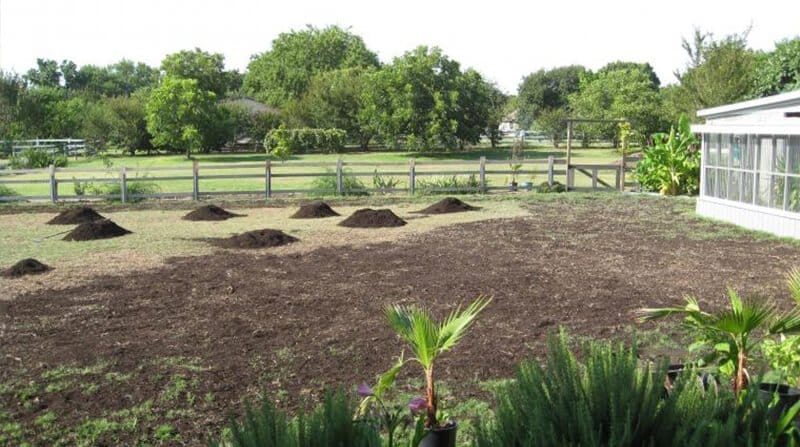
Now we have solved the drainage issue in the soil, it’s time to address its fertility and improve the structure.
In order to put nutrients back into the lawn, top dress your lawn with a nutrients rich topsoil.
For best results on larger areas, use a quality finely graded topsoil (I highly recommend Rolawn) which is free of weeds. If you are just doing a small area, then a smaller cheap bag like Westland Top Soil should do the job.
Distribute the soil into little piles across the lawn before working it into the lawn with the back of a landscaping rake.
Step 5: Overseed the Lawn With New Grass Seed
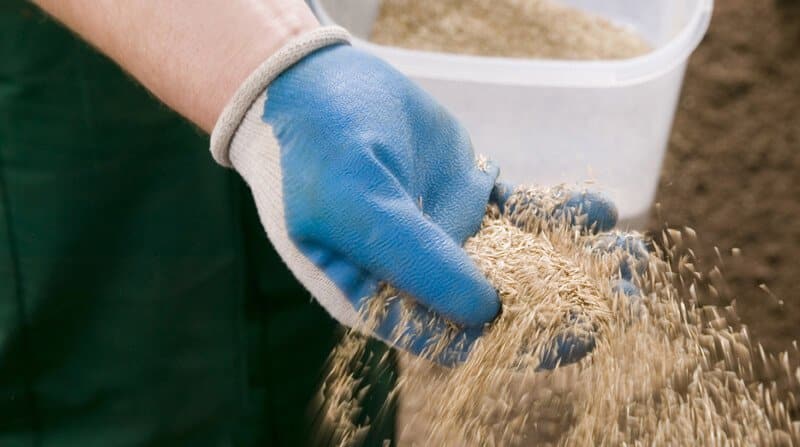
Once you have top dressed with some new, fertile soil, it’s time to sow some new grass seed to replace all the Dog Lichen, moss and thatch.
You’ll need to choose your grass seed carefully depending on the type of lawn you want to create.
If you’re creating a play area for your kids or pets, you might choose a hard-wearing grass seed mix.
Or do you want a hard-wearing lawn that also has a luxury look and feel? In which case choose a multi-purpose seed blend.
Maybe you want an ornamental lawn. If so, choose an ornamental lawn seed.
Is your lawn covered by lots of shade? Choose a seed mix that’s designed for shady lawns.
For more information on choosing a grass seed for your lawn, read my guide to the best grass seed.
You can spread grass seed by hand fairly accurately on small lawns but still, I prefer to use a spreader – especially on large lawns, they’re just more accurate.
Step 6: Apply a Slow-Release, Pre-Seeding Fertiliser
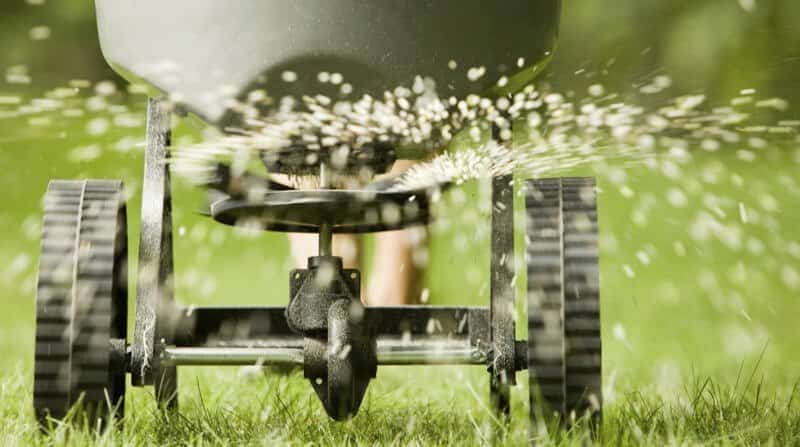
To aid germination and growth, spread a slow-release, pre-seeding fertiliser.
Pre-seeding fertiliser doesn’t contain as much nitrogen as other fertilisers which can be too strong for grass seedlings. Instead, it helps with root development and encourages the grass to grow strong.
Like grass seed, you can apply it by hand but it’s much more accurate if you use a spreader.
Step 7: Roll, Tread, or Brush the Lawn
Now you’ve spread the grass seed and fertiliser you need to make sure it has good contact with the soil.
The best way to do this I find is with a stiff brush to brush the seed and fertiliser into the soil.
You can also use a lawn roller to press the seed and fertiliser into the soil.
At the very least, tread it into your lawn using small steps up and down the lawn.
Step 8: Keep the Ground Moist by Watering
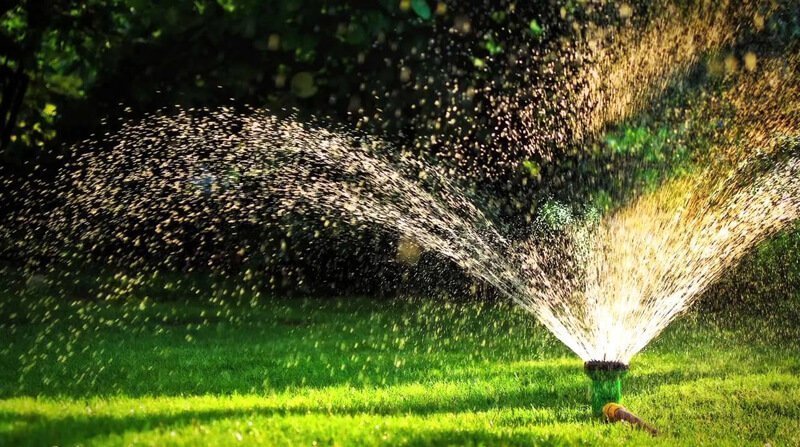
The last thing to do is to keep the lawn moist.
If you do these jobs in the autumn or spring, you should hopefully have a good supply of rain. If it’s dry you’ll need to water the lawn for an hour or so every couple of days to keep moisture in the soil.
If you need to water, use a sprinkler system with a fine spray as to not drown the grass seed or wash it away.
You should see the grass starting to germinate and shoot within days. Germination can take anywhere from 7-30 days depending on the weather and other conditions. That said, you’ll usually see results with two weeks.
How to Prevent Dog Lichen From Growing Back
By now you’ll have spent a ton of time, energy and money to renovate your lawn and rid it of Dog Lichen, moss and thatch.
Once fully recovered your lawn will look beautiful again.
But how do you prevent Dog Lichen from growing back after working so hard?
Reduce the Amount of Shade and Improve Air Flow Through Your Garden
If shade is cast by buildings then chances are you won’t be able to reduce it or improve airflow through your garden.
However, you can improve conditions by;
- Pruning trees and low hanging branches – trim back trees and try to make sure the lowest branches are at least 3 feet off the ground.
- Prune thick bushes – this will allow light and air to pass through them much more easily.
- Replace fence panels – granted, this is on the more extreme end but replacing solid fence panels with slotted fencing will greatly improve things.
Apply Good Lawn Care Practices
Good lawn care practice is the single most important way of maintaining a healthy lawn and prevent Dog Lichen from growing.
Lawns grown in shady areas on poor soils can still look beautiful if you apply good practice.
Here’s how do do it:
- Mow the lawn regularly – the single most important part of good lawn care. Between April and September, cut the grass at least once every 7-10 days. When grass is growing at its fastest (usually in May and September) cut it every 5-7 days. This will force the grass to shoot and grow sideways, creating a thicker lawn with more grass.
- Spike the lawn in the spring and autumn – to keep soil compaction to a minimum and drainage at it’s best, spike the lawn with a garden fork or aeration sandals. Do it in spring and autumn when the ground is soft. Avoid doing it in the summer as the heat could dry the lawn out.
- Keep the soil fertile – fertilising in the spring and autumn will keep the soil fertile and give the grass everything it needs to produce food and stay healthy. Healthy grass will outcompete moss and other infestations from weeds and disease.
Wrapping Up
Dog Lichen isn’t the problem in your lawn, it’s the symptom of other problems.
And as with any other lawn problems, it can be fixed with good lawn care practices. If you fix the issues in your lawn and look after it, you’ll never see it again.
Over to You
Have you got Dog Lichen in your lawn and if so, how are you going to fix it?
Have you had it in the past?
Let me know in the comment section below.
As always, questions and other comments are welcome.
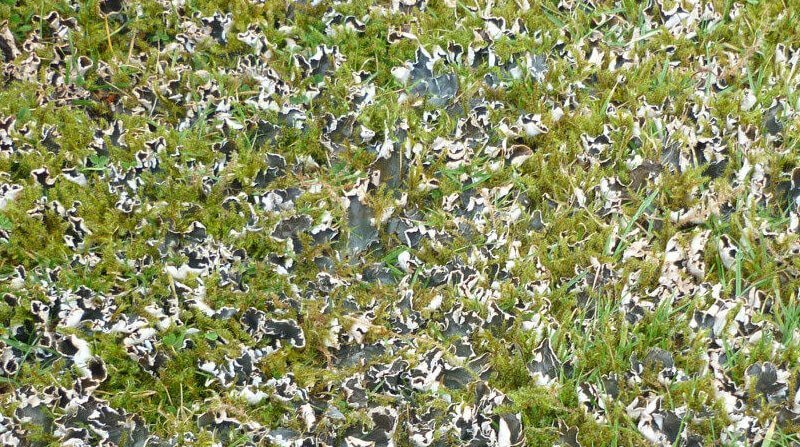

Hi Tom,
We fist noticed the Dog Lichen ( well we think it is Dog Lichen ) last year and followed your instructions to kill the moss and we even bought an electric Scarifier and took the lawn right back, it was almost bare in places so we used a good quality grass seed and it eventually grew back it looked a lot better but over the summer the lichen started to re appear in several places, when we saw a patch we would rake it out and aerate the patch , we are having no luck getting rid of it can you advise please